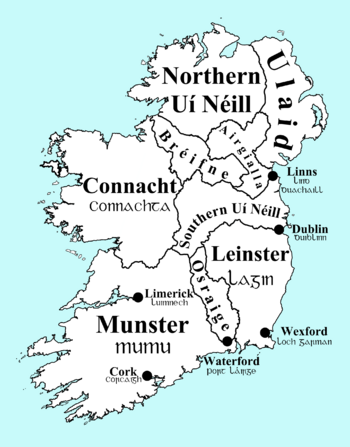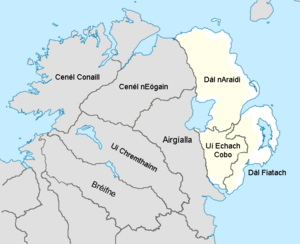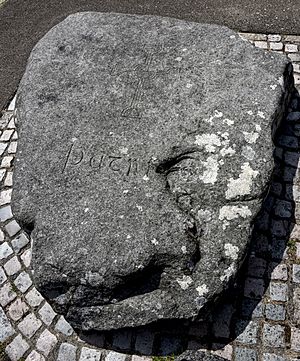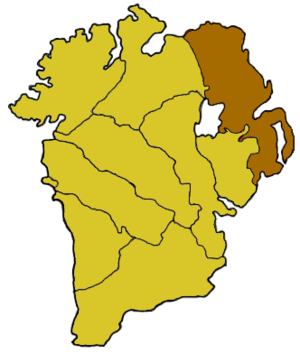Ulaid facts for kids
Quick facts for kids
Ulaid
|
|||||||||
|---|---|---|---|---|---|---|---|---|---|
| Before 450 – 1177 | |||||||||

Map of Ireland's over-kingdoms circa 900 AD.
|
|||||||||
| Capital | Various | ||||||||
| Common languages | Irish | ||||||||
| Government | Monarchy | ||||||||
| King | |||||||||
|
• –465
|
Forga mac Dallán | ||||||||
|
• 1172–1177
|
Ruaidrí Mac Duinn Sléibe | ||||||||
| History | |||||||||
|
• Established
|
Before 450 | ||||||||
|
• Disestablished
|
1177 | ||||||||
| ISO 3166 code | IE | ||||||||
|
|||||||||
| Today part of | |||||||||
Ulaid (pronounced "OO-lath" in Old Irish) was a powerful kingdom in north-eastern Ireland during the Middle Ages. It was made up of different family groups working together. You might also hear it called Ulidia, which is its Latin name, or in Cóiced, which means "the Fifth" in Irish. The ruler of Ulaid was known as the rí Ulad or "king of Ulaid."
The name Ulaid also refers to the people who lived there a long time ago. The modern-day province of Ulster gets its name from them. Some ruling families in the kingdom claimed to be descendants of the Ulaid people. Others were said to be from a group called the Cruithin. In old writings, "Ulaid" often meant the people ruled by the Dál Fiatach family. So, the title "King of Ulaid" could mean both the king of the Ulaid kingdom and the leader of the Dál Fiatach people.
The Ulaid are very important in old Irish stories, especially in the Ulster Cycle of Irish mythology. These legends say that the ancient Ulaid kingdom covered most of what is now Ulster. This included County Louth but not County Cavan. Its southern border supposedly stretched from the River Drowes in the west to the River Boyne in the east.
By the 6th century, Ulaid's territory was mostly east of the River Bann. This was because they had lost land to other groups like the Airgíalla and the Northern Uí Néill. Ulaid stopped being a kingdom after it was taken over in the late 12th century. This happened when the Anglo-Norman knight John de Courcy conquered it. The Earldom of Ulster then took its place.
Someone from Ulaid was called an Ultach in Irish. This name lives on today in surnames like McAnulty or McNulty. These names come from Mac an Ultaigh, meaning "son of the Ulsterman."
Contents
Understanding the Name Ulaid
The word "Ulaid" is a plural noun and originally referred to a group of people. Over time, names of people and important ancestors became linked to specific places. This happened even if the ruling family wasn't directly related to that ancestor. This is how "Ulaid" became the name of a kingdom.
Ulaid was also known as Cóiced Ulad, or "the Fifth of Ulster." It was one of the five legendary provinces of Ireland. After losing land to the Airgíalla and Northern Uí Néill, the remaining eastern part of the kingdom was sometimes called in Cóiced. This simply meant "the Fifth," referring to the part of the original "Fifth of Ulster" that was still unconquered.
Historians believe the Ulaid might be the "Uoluntii" or "Voluntii" mentioned in Ptolemy's Geographia from the 2nd century. This name might come from the Gaelic word ul, meaning "beard."
"Ulaid" has been spelled in English as "Ulagh" or "Ullagh." In Latin, it became "Ulidia" or "Ultonia." These Latin forms gave us words like "Ulidian" and "Ultonian." The Irish word for a person from Ulaid is Ultach.
The name Ulaid gave its name to the province of Ulster. The exact way this happened is debated. It might come from "Ulaidh" with a Norse "s" and the Irish word tír (meaning "land"). Or the second part might be the Norse "-ster," which means "place."
People of Ulaid
Old traditions say that the ruling families of Ulaid were either from the Ulaid people or the Cruthin. Medieval Irish family historians said the Ulaid were descendants of the legendary High King of Ireland, Rudraige mac Sithrigi. The Cruthin, on the other hand, were the Irish term for the Picts. They were thought to be more powerful and numerous at first. In early records, "Ulaid" often referred to the Dál Fiatach family, and "Cruthin" to the Dál nAraidi. These were the two most powerful groups.
Many scholars believe the Ulaid were related to the Érainn people. Some even think the Ulaid were a branch of the Érainn. The Dáirine, another name for the Érainn royalty, might also be connected to the "Darini" mentioned by Ptolemy.
However, the true family history of the people and groups within the Ulaid kingdom is not always clear. For example:
- The Dál Riata, Dál Fiatach, and Uí Echach Arda were considered Ulaid. But the Dál Riata and Dál Fiatach claimed to be from the Érainn. Still, the term Ulaid referred to the Dál Fiatach until the Anglo-Norman conquest.
- The Conaille Muirtheimne, Dál nAraidi, and Uí Echach Cobo were counted as Cruthin. But after the 8th century, some writings called them the fír Ulaid, meaning "the true Ulaid."
History of the Ulaid Kingdom
Early Days of Ulaid
Ptolemy's Geographia, written in the 2nd century, places the "Uoluntii" in the southeast of what is now Ulster. This was south of the River Lagan and north of the River Boyne. Another 7th-century writer, Muirchú, also said the "Ulothi" lived between the Lagan and the Boyne.
In the Ulster Cycle of Irish mythology, the ancient Ulaid are said to have ruled all of northern Ireland. Their capital was at Emain Macha (Navan Fort), near modern-day Armagh. Legends say that around 331 AD, a group called the Three Collas invaded Ulaid. They destroyed Emain Macha and pushed Ulaid into the eastern part of its territory. This new border was east of the Lower Bann and Newry River. The land the Three Collas conquered became the kingdom of Airgíalla.
Another story says Emain Macha fell in 450 AD, around the time of Saint Patrick. This might explain why Patrick chose Armagh, near Emain Macha, for his church. It might also explain why he was buried in eastern Ulster, as Armagh may have been under Airgíalla control by then. It's likely that the Airgíalla were not new settlers. They were probably local tribes who used to be under Ulaid's rule but then became independent.
By the end of the 5th century, a Ulaid group called the Dál Riata began settling in modern-day Scotland. They formed a kingdom that stretched across the sea. Their first settlements were in the area of Argyll.
From the 6th to 7th Centuries
In the mid-6th century, the Dál Riata in Scotland faced threats from the king of the Picts. They asked the Northern Uí Néill for help. The Dál Riata king, Áedán mac Gabráin, had already given the island of Iona to Saint Columba. Columba helped arrange an alliance between the Northern Uí Néill and Dál Riata in 575. This agreement freed Dál Riata from Ulaid's rule, allowing them to focus on their Scottish lands.
In 563, a conflict among the Cruthin led to a deal with the Northern Uí Néill. The Northern Uí Néill gained land west of the River Bann. This led to a big battle where the Cruthin were defeated. Afterward, the Northern Uí Néill settled their allies, the Airgíalla, in the Cruthin territory between the River Bann and the River Bush.
The Dál nAraidi king Congal Cáech became the ruler of Ulaid in 626. In 628, he killed the High King of Ireland in battle. Congal tried to become High King himself. He made alliances with Dál Riata and Strathclyde. This led to the terrible Battle of Moira in 637, where Congal was killed. Dál Riata also lost its Scottish lands in this battle.
In 668, a battle took place in modern-day Belfast between the Ulaid and Cruthin. These terms referred to the Dál Fiatach and Dál nAraide at that time.
From the 8th to 10th Centuries
By the 8th century, Ulaid's territory had shrunk to east of the Bann. This area is now Antrim, Down, and Louth. In 732 or 735, the Ulaid suffered a major defeat. Their king, Áed Róin, was beheaded. As a result, another group took control of Conaille Muirthemne.
The Ulaid and the Northern Uí Néill were often enemies because the Northern Uí Néill had taken Ulaid's old lands. In the 8th century, the Dál nAraidi took over the kingdom of Dál Riata.
The Dál Fiatach family ruled Ulaid until 827. They tried to free Airgíalla from the Northern Uí Néill but failed. The Dál Fiatach may have been busy with Viking bases around Strangford Lough. By the end of the century, the Dál nAraidi had become more powerful than them. However, this only lasted until 972, when Eochaid mac Ardgail brought the Dál Fiatach back to power.
During the 9th and 10th centuries, Vikings set up bases in Ulaid. These were mainly at Annagassan, Carlingford Lough, Lough Neagh, and Strangford Lough. There was also a big port at Ulfreksfjord, in modern-day Larne. Most of these Viking bases were destroyed by the Ulaid and Northern Uí Néill working together. However, this meant they missed out on the economic benefits these settlements could have brought.
The 11th Century in Ulaid
In 1000, Brian Boru, the High King of Ireland, expelled the Viking king of Dublin, Sigtrygg Silkbeard. The Ulaid refused to give Sigtrygg a safe place. Sigtrygg had to return to Dublin and submit to Brian. Sigtrygg did not forget the Ulaid's refusal. In 1001, his fleet attacked places in Dál Fiatach, taking many prisoners. Sigtrygg's forces also helped Brian in his campaigns against the Ulaid in 1002 and 1005.
In 1003, the Northern Uí Néill and Ulaid fought a big battle at Craeb Telcha, an important Ulaid site. The king of Ulaid, Eochaid mac Ardgail, and many Ulaid nobles were killed. This led to a bloody fight for power among the Dál Fiatach princes. They also had to fight the Dál nAraidi, who wanted the kingship.
In 1005, Brian Boru marched north to receive submissions from the Ulaid. He camped at Emain Macha, possibly to use its symbolic importance to the Ulaid. From there, Boru marched to the Dál nAraidi capital. He received submissions only from their king and the Dál Fiatach king. This seemed to cause a series of attacks by Flaithbertach Ua Néill, king of the Cenél nEógain, to punish the Ulaid.
The battle of Craeb Telcha meant the Ulaid could not help Brian Boru much in 1006. That year, Boru led an army from all over Ireland to force the Northern Uí Néill to submit. He marched through their lands and into Ulaid, where he received submissions from the Ulaid at Craeb Telcha.
Flaithbertach Ua Néill continued his attacks on Ulaid in 1007. In 1011, Flaithbertach invaded Ulaid. He destroyed Dún Echdach and took the submission of the Dál Fiatach. This removed them from Boru's control. The next year, Flaithbertach raided the Ards peninsula and took many treasures.
In 1018, a combined force of Irish and Norse allies defeated a major Viking expedition. This expedition was led by the Earl of Orkney, who wanted to control the sea routes between Ireland and Scotland. In 1022, Niall mac Eochaid, the king of Ulaid, heavily defeated Sigtrygg's Dublin fleet. He destroyed it and captured its crew. Niall followed this victory by attacking a Viking settlement near Dublin in 1026.
Sigtrygg's nephew attacked Rathlin Island off the coast of Ulaid in 1038 and again in 1045. In the second attack, he killed the heir to Ulaid and many Ulaid nobles. In return, Niall attacked the Viking settlement again. In 1087, a son of the king of Ulaid, allied with two grandsons, attacked the Isle of Man. They tried to remove the king of Dublin and the Isles but failed.
At the end of the 11th century, the Ulaid had a final strong period under Donn Sléibe mac Echdacha. His family, the Mac Dúinn Shléibe, ruled Ulaid in the 12th century. They kept the Dál Fiatach kingship after 1137. They also had close ties with the kingdom of the Isles. The Mac Dúinn Shléibe kings fought hard to keep Ulaid independent from the powerful Mac Lochlainn rulers of the Northern Uí Néill.
The 12th Century and the Normans
By the early 12th century, the Dál nAraidi had lost control of most of Antrim. They were limited to a small area in south Antrim. Other groups, like the Ua Flainn, became powerful in Antrim. They called themselves kings of Dál nAraidi and other areas.
By 1130, the southernmost part of Ulaid had been conquered by the king of Airgíalla.
In 1157, the High King Muirchertach Mac Lochlainn granted land to monks in Newry. This was done with the agreement of the king of Ulaid and other local rulers.
In 1165, the Ulaid, led by Eochaidh Mac Dúinn Sléibe, turned against Muirchertach Mac Lochlainn. They attacked other groups. In response, Mac Lochlainn led an army into Ulaid, killing many and removing Eochaid from power. Eochaid tried to get his kingship back, but his own people feared Mac Lochlainn's revenge. Mac Lochlainn then raided Ulaid again, taking hostages and treasure. Later, Eochaid made a deal to get his kingship back. He gave Mac Lochlainn hostages, including his own daughter, and a lot of treasure and land. Mac Lochlainn swore an oath to behave. But despite his oath, Muirchertach had Eochaid captured and blinded. His allies then left him, and he was killed in 1166.
In 1170, Eochaid's brother Magnus, who became king of Ulaid, expelled some monks from Saul.
Even with all this trouble, Ulaid survived for a little longer. In 1177, Ulaid was invaded by the Normans led by John de Courcy. He surprised them by capturing the Dál Fiatach capital, Dún De Lethglaise (Downpatrick). The Ulaid king, Ruaidrí Mac Duinn Sléibe, had to flee. A week later, he returned with a large army, but de Courcy's smaller force defeated them. Mac Duinn Sléibe tried again with an even bigger army, including other Ulster leaders. But the Normans won again, capturing important religious figures and their treasures.
In 1178, Mac Duinn Sléibe and the king of Airgíalla attacked the Normans. They killed many Normans, but also lost some of their own men.
Despite forming alliances, the Ulaid kept fighting among themselves and with their Irish neighbors. They didn't seem to notice the growing threat from the Normans. De Courcy used this instability to his advantage. Over the next few years, he conquered nearby areas in Ulaid, shifting the balance of power.
By 1181, Mac Duinn Sléibe and another king had become loyal to de Courcy. Mac Duinn Sléibe might have encouraged de Courcy to expand west. This led to attacks on Armagh in 1189 and then Derry in 1197.
De Courcy called himself "master of Ulster" and ruled his conquered lands like an independent king. However, one area, Uí Echach Coba, in central and western Down, managed to avoid being conquered.
In 1199, King John I of England sent Hugh de Lacy to arrest de Courcy. In 1205, de Lacy became the first Earl of Ulster. He continued the conquest of Ulaid. The earldom expanded along the northern coast of Ulster.
Until the end of the 13th century, the Dál Fiatach still had some power. They were called "king of the Irish of Ulaid." After the Dál Fiatach line ended, the Ó Néills took over the title of "king of Ulster."
Religion in Ulaid
Ulaid was where Saint Patrick, the future patron saint of Ireland, was held captive when he was young. It was here that he made the first Irish converts to Christianity. The Dál Fiatach were the first ruling family to become Christian. Patrick died at Saul and was buried at Dún De Lethglaise. In the 13th century, this place was renamed Dún Phádraig, which became Downpatrick.
When Ireland's church system was organized in the 12th century, new areas called dioceses were created. These were based on the territories of the main Ulaid families. The diocese of Down was based on the Dál Fiatach territory. Its main church was first at Bangor, but later moved to Downpatrick by John de Courcy. The diocese of Connor was based on the Dál nAraidi territory. Around 1197, the diocese of Down was split. The diocese of Dromore was created, based on the territory of the Uí Echach Cobo.
Important Churches and Monasteries
The main churches or monasteries in Ulaid's sub-kingdoms were:
- Movilla (Irish: Maigh Bhile): This was the main church of the Dál Fiatach. It was founded around 540 by St. Finnian of Movilla, who was from the Dál Fiatach family. Its name suggests it was built on a site with an ancient sacred tree.
- Bangor (Irish: Beannchar): Built around 555 or 559 by St. Comgall of the Dál nAraidi. It was one of Ireland's most important monasteries.
- Connor (Irish: Coinnire): This was the main church of the Dál nAraidi. It was founded by St. Mac Nisse and later became the main church for the diocese of Connor.
- Armoy (Irish: Oirthear Maí): This was the main church of the Dál Riata. It lost its importance after the Dál nAraidi expanded in the 7th century.
- Dromore (Irish: Droim Mór): This became the main church of the Uí Echach Cobo. It was founded around 510 by St. Colmán and later became the main church for the diocese of Dromore.
Ancient Artefacts
Not many ancient La Tène artefacts have been found in Ireland. However, most of the ones discovered (mostly weapons and horse gear) were found in northern Ireland. This suggests that small groups of settlers, like warriors and metalworkers, arrived from Britain around the 3rd century BC. They might have joined the Ulaid population.
Kingdoms and Families within Ulaid
By the 12th century, Ulaid was divided into four main sub-kingdoms. Each of these had smaller kingdoms within them:
- Dál Fiatach: These were Ulaid people based at Dún De Lethglaise (Downpatrick, County Down). They were the most powerful and often ruled the entire Ulaid kingdom. They also had interests in the Isle of Man. Their main family was the Mac Duinnshléibhe.
- Dál nAraidi: These were Cruthin people, mainly the Dál nAraidi of Magh Line, based near Antrim town, County Antrim. They were the main rivals to the Dál Fiatach for the kingship of Ulaid.
- Uí Echach Cobo: A Cruthin family related to the Dál nAraidi. They also tried to become kings of Ulaid. They were based in modern-day County Down. Their main family was the Mag Aonghusa.
- Uí Tuirtri: Originally from Airgíalla, they took control of most of the Dál nAraidi's land. Their main family was the Uí Fhloinn.
Old records from the 10th century list twelve smaller kingdoms that paid tribute to the king of Ulaid. Some of these included:
- Dál nAraidi of Magh Line
- Cobha, ruled by the Uí Echach Cobo
- Dál Riata, located in the Glens of Antrim
- Conaille Muirtheimne, located around Dundalk, County Louth
- Na hArda, located in the northern part of the Ards peninsula
Other areas and families in Ulaid included:
- Cuailgne: Located near Carlingford Lough and Dundalk, County Louth. Its name is kept in the Cooley Peninsula. This area is famous as the setting for the Táin Bó Cúailnge (Cattle Raid of Cooley) legend.
- Dál Sailni: A smaller kingdom that served the Dál nAraidi. It held the important church of Connor.
Families Descended from Ulaid
The first king of Scotland, Kenneth MacAlpin, who founded the House of Alpin, is said to be a descendant of a Dál Riata king from the mid-6th century. Also, several Scottish Highland families are believed to have Ulaid ancestors. These include the McEwen, MacLachlan, McNeills, and the MacSweens. The royal House of Stuart is also claimed to be descended from the Ulaid.
Ulaid in Old Stories
According to medieval writers, a group of brothers called the Three Collas founded the kingdom of Airgíalla in the 4th century. They supposedly defeated the Ulaid and destroyed their ancient capital, Emain Macha. However, this story is not historically accurate.
The Ulaid are very important in Irish legends from ancient times, especially in the stories known as the Ulster Cycle. These tales are set during the reign of the Ulaid king Conchobar mac Nessa at Emain Macha (Navan Fort, near Armagh). They tell of his battles with the Connachta, led by Queen Medb. The main hero is Conchobar's nephew, Cú Chulainn. The most famous story is the epic Táin Bó Cúailnge, or "The Cattle Raid of Cooley."
In these stories, Ireland was divided into five independent kingdoms, or cuigeadh (meaning "a fifth"). Ulaid was one of them, with its capital at Emain Macha. This time was called "Time of the Pentarchs" or "Time of the Five Fifths."
Some scholars believe the Ulster Cycle stories came from wars between the Ulaid and other Irish groups in the 4th and 5th centuries. During these wars, the Ulaid lost much of their land and their capital to new kingdoms. Traditional history says the Three Collas defeated the Ulaid king and burned Emain Macha in 331 AD. This king was said to be the last Ulaid king to rule there.
Cultural Impact of Ulaid
There are two towns in North Carolina, United States, that are likely named after Ulaid: Mount Ulla and Ulah.
The Ulaid have also inspired the name of a traditional Irish music group called Ulaid. This group features Dónal O'Connor, John McSherry & Seán Óg Graham, and they have released two popular albums.
See also
- Cruthin
- List of kings of Ulster
- List of clans and septs in Ulaid
- Osraige
- Early history of Ireland
- Early Medieval Ireland 800–1166




